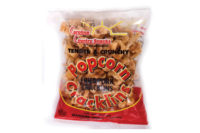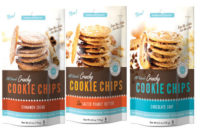A cocoa alternativeInnovations in the chocolate and cocoa segments are providing healthier, more sustainable alternatives for baked goods and snack food producers.
Most people don’t consider the words “healthy” and “chocolate” to be synonymous, but recent research may one day change that perception.
More than 50 leading experts, including representatives from candy giant Mars Inc., McLean, Va., gathered in Brussels in late June to discuss recent breakthroughs in the field of cocoa flavanol research and the key findings of FLAVIOLA, a European Union-funded consortium dedicated to state-of-the-art research into flavanols.
Through collaborative and cutting-edge research, the consortium says it seeks to lay the foundation for the development of evidence-based dietary recommendations and innovative food products that harness the benefits of flavanols for cardiovascular health.
Future research aside, the chocolate confectionery market has fared seemingly well in the still-lagging economy, growing 19% from 2007 to 2012, according to Chicago-based research firm Mintel. This growth can be attributed to consumers’ desires for affordable luxuries or indulgences, as well as the foodie culture that has increased interest in premium, high-quality and artisanal varieties of chocolate.
However, due to the countering trends of obesity and other health issues, Mintel says it expects the chocolate confectionery category to slow down in the next five years, with sales growing 15% from 2012 to 2017.
Chocolate innovations
As concerns about health and well-being rise, consumers want foods with health benefits, even when it comes to treats. “Nutritive claims are important because consumers want to be able to indulge while doing something good for their health,” says Courtney LeDrew, cocoa and chocolate marketing manager at Cargill, Minneapolis. “Chocolate offers a great way to mask the flavors of added nutrients. As a result, there are many opportunities for innovative, fortified confectionery coatings that will help contribute to a nutrient content claim for protein.”
With that, Cargill has launched confectionery coatings fortified with 20% total protein in dark and cocoa flavor options under the Wilbur chocolate brand. The coatings are formulated with whey protein and made without hydrogenated fat. “To avoid adding extra fat and calories, Wilbur protein coatings contain larger particles, which allow more free fat to circulate in the coating without increasing overall fat content,” LeDrew explains. “Ultimately, this maintains the ideal viscosity for enrobing or bottoming nutrition or snack bars.”
Because consumers like to experiment with new food experiences, manufacturers are taking advantage of chocolate pairing opportunities. In the last year, ADM Cocoa in Milwaukee introduced several new products, including combinations of chocolate-with-salt, chocolate coatings and confectionary coatings featuring black and royal blue colors. “The innovations we are seeing include new cocoa flavors, more intense and indulgent cocoa flavors and more intense cocoa colors,” says Neil Widlak, director of product services and development for ADM.
Recently, ADM Cocoa expanded its cocoa powder offerings under the deZaan brand. Following the launch of deZaan D11EB, an extra-black cocoa powder, and the Fresco Cacao range featuring deZaan F11FR, a fruity, non-bitter cocoa powder suited to yogurt and fresh fruit applications, ADM launched deZaan D11SQ cocoa powder, which offers an intense cocoa and chocolaty taste and a dark brown color to complement the flavor intensity.
“Pairing chocolate with certain foods and identifying foods that go well together is based on a principle that foods combine well with one another when they have key flavor components in common,” says Dana Koc, product manager, chocolate, for Puratos, Belgium. “This inspires professionals to enhance flavors in traditional recipes or create new applications by combining chocolate with a variety of often surprising foods.”
Many of Puratos’ customers want to use one product or ingredient in many recipes to increase inventory efficiencies and decrease waste, she explains. As a result, the company’s technical staff and application specialists have focused on developing recipes and new applications using its current product line to help customers expand their offerings and remain efficient.
“Chocolate products need to taste great, but be easy to use and hold up in harsh conditions,” Koc adds. “On the other hand, for our customers, ease-of-use and product stability are musts in order to produce a consistent product and deliver what consumers have come to expect.”
Balancing act
A number of consumer food trends continue to impact the chocolate and cocoa segments. In 2013, sales of energy/nutrition bars are predicted to jump 14%, surpassing those of cereal/granola bars, which are expected to increase more than 4%, according to Packaged Facts’ report “Food Bars in the U.S.: Cereal/Granola Bar and Energy/Nutrition Bar Trends.”
“Consumers are seeking nutritious snacks throughout the day, such as snack and nutrition bars, for reasons like wellness, weight management, meal replacement and muscle recovery,” LeDrew says.
“The focus on healthier eating and childhood obesity has also led to a decrease in the use of hydrogenated chocolate coatings,” Widlak says. Although consumers are seeking to eat healthier, they also want to indulge more often, so the need to eat nutritionally-balanced snacks hasn’t yet outweighed the importance of taste.
“In the U.S., smaller, high-calorie products, such as chocolate and patisserie, are likely to be eaten as snacks by 61% of consumers,” Koc says. “So consumers’ food choices aren’t so much about diet, but about striking a balance between the pleasure of eating and the health benefits that food provides.”
Portion control is also a consideration for many consumers. “Bite-size cakes may come three to a package and be enough to satisfy a craving for a piece of cake,” says Rose Potts, corporate manager, sensory and product guidance, at Blommer Chocolate Co., Chicago. “Multiple pieces in a pack can also provide sharing opportunities, which is important to the way the consumer experiences food.”
When it comes to taste, many people also are seeking out products that reflect simpler times and provide a feeling of authenticity and comfort. “This can mean different things to different consumers,” says Potts. “To some consumers, such as millennials, it can mean taking extreme and novel-flavored coatings or drops and combining them in a product that reminds us of flavors from grandmother’s kitchen.”
To that end, Blommer recently introduced several products for the baking and snack foods segments. “We have a number of flavors and novelties that work well with specialty seasonal items as well as innovative items that can become part of a customer’s regular product line,” Potts says. New flavors include Dulce de Leche; cream cheese low-melt drops; cobbler-flavored drops; lemon chiffon coating; coconut-flavored coating; Greek Yogurt-flavored coating; birthday cake coating; salted caramel-flavored coating; sour apple-flavored drops; and a Boston cream-flavored filling.
The healthier eating trend also has led to cleaner labels. “People want to know what’s in their food and where it comes from,” Potts continues. “Chocolate can have a very simple list of ingredients, such as chocolate liquor, sugar, lecithin and vanilla. A simple list of ingredients has consumer appeal.”
The fair trade factor
Fair trade continues to be a growing concern when it comes to the production of food ingredients, including cocoa and chocolate. As demand for sustainable products continues to increase, farmers in cocoa-growing areas are struggling to sustain yields, while facing socio-economic problems in their communities. Greater consumer awareness of the need for sustainable practices is spurring increased demand for certified cocoa and chocolate.
“Simplicity or authenticity can be addressed by using sustainable, certified chocolate ingredients so that we are assured that the Earth and the people that produce the cacao products are being well served,” says Potts. As a result, sustainable products, sourced either through a private program or through mainstream certifiers such as Rainforest Alliance, UTZ Certified or fair trade organization are in high demand.
The Cargill Cocoa Promise is Cargill’s global commitment to supporting the development of a sustainable cocoa supply chain and making a difference in three key areas: Improving the lives of cocoa farmers; supporting cocoa farming communities; and investing in the future of cocoa farming.
“However, we know we cannot develop a sustainable cocoa supply chain alone,” says LeDrew. “That’s why the Cargill Cocoa Promise is about working with farmers, customers, nongovernmental organizations (NGOs) and governments to make a difference together. Certification is an important tool under the Cargill Cocoa Promise because it provides reassurance, credibility and greater transparency to consumers. It also enables food manufacturers to demonstrate commitment to supporting a sustainable supply chain.”
Fair trade products can lead to an opportunity for companies to present a story surrounding a product and give a holistic quality to the buying experience. “Consumers are becoming more in touch with the supply chain and want to understand what they’re contributing to, hence the push for the use of exclusively certified cocoa,” Koc says. “With just more than 10% of the world cocoa being certified, and most of the major chocolate retailers in the world announcing aggressive plans over the next eight years, a lot of work will need to be done at origin to ensure that these commitments can be realized.”
Currently, there’s an aggressive push at origin to get more farmers and co-ops certified sustainable, either through third-party certifications or supplier-driven programs. “This hasn’t been enough to address the full needs of the industry, however,” Koc says. “With a consumer/industrial push for certified cocoa and full traceability, it stands to reason that the trend will grow.”
Sustainable cocoa has been on the radar for Blommer Chocolate since the 1950s, when Henry Blommer traveled to the country from which the company sourced its cocoa. He was also a founding member of the organization that was the precursor to the World Cocoa Foundation.
The Blommer Sustainable Origins program encompasses a number of sustainability initiatives, which tie into providing certified cacao from major third-party certifiers such as fair trade organizations, UTZ Certified and the Rainforest Alliance, in addition to custom programs.
“Blommer has always been concerned about the steady supply of quality cacao and the livelihood of the people that provide it to our industry,” Potts explains. “The demand for sustainable cacao has grown exponentially over the past year, and to satisfy this demand, all of the certification agencies are needed. In the confectionary industry, there have been bold initiatives to be 100%-sustainably-sourced by 2020.”
Still, the focus on fair trade presents challenges in marketing and procurement. “For example, fair trade beans limit the variety of flavors compared to the diverse chocolate flavors found in current bean sources,” Widlak says.
Full protein ahead
Manufacturers anticipate incorporating plenty of cocoa and chocolate into healthier baked goods and snack items going forward. “Evidence indicates that protein is a long-term trend and not a fad,” LeDrew says. “Protein products have become applicable to a wide audience, from aging Baby Boomers and individuals trying to maintain or lose weight to athletes and anyone seeking products that keep them fuller longer. Chocolate and protein pair well together.”
As the market continues to evolve and expand into the developing markets, supply becomes an issue and is the reason for the push for more sustainable cocoa. “As the supply becomes tighter, and prices reflect this tightness, consumers are going to expect more if they’re paying more,” Koc says.
The sustainable market will continue to gain steam as more customers demand it and retailers write it into their specifications. “Bakery and snack food companies should be working to establish their stance on how they will be address sustainable sourcing,” Potts says.
The significance of chocolate and cocoa will never go away, however. Nor will their enchanting taste. So one way or another, this pair will survive the tests of time.
|
A cocoa alternative |
|
While consumer demand for products made with real chocolate, nuts, fruits and so on continues to grow, bakers and snack producers often use alternative ingredients in their formulations for a variety of reasons, such as usability, availability and cost. Briess Malt & Ingredients Co., Chilton, Wis., for instance, has developed a cocoa alternative called the Cocoa Plus line. Made from roasted barley, it mimics the texture and flavor of cocoa and comes in a variety of colors, from light brown to red and black. “The advantage is that Cocoa Plus is a whole-grain and caffeine-free product,” says Judy Giedel, Briess’ technical service representative. “This ingredient cannot be a 100% replacement for cocoa, but depending upon which type of product it’s used in, it can replace up to 25% of standard cocoa in baked goods. It also has a similar shelf life to cocoa.” Briess’ line of Cocoa Plus colors can typically be matched to cocoa from specific regions. Unlike real cocoa, this product is recommended as an ingredient in further-processed products. “The formulating potential with this line is very extensive, and we’ve only started exploring its applications,” says Bernadette Wasdovitch, Briess’ marketing communications manager. |









